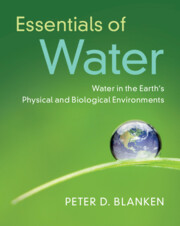Book contents
- Essentials of Water
- Reviews
- Essentials of Water
- Copyright page
- Contents
- Preface
- Acknowledgments
- 1 The Historical Significance of Water
- 2 The Composition of Water
- 3 The Properties of Water
- 4 The Origin of Water
- 5 The Distribution of Liquid Water
- 6 The Distribution of Ice
- 7 Evaporation, Condensation, and Precipitation
- 8 Melting and Freezing, Sublimation and Deposition
- 9 Warm-Region Abiotic Processes and Landforms
- 10 Cold-Region Abiotic Processes and Landforms
- 11 Water within Vegetation
- 12 Transpiration
- 13 Water and Thermoregulation: Ectotherms
- 14 Water and Thermoregulation: Humans
- 15 Water Quality
- 16 Changes in Evaporation and Humidity
- Index
- References
16 - Changes in Evaporation and Humidity
Published online by Cambridge University Press: 02 October 2024
- Essentials of Water
- Reviews
- Essentials of Water
- Copyright page
- Contents
- Preface
- Acknowledgments
- 1 The Historical Significance of Water
- 2 The Composition of Water
- 3 The Properties of Water
- 4 The Origin of Water
- 5 The Distribution of Liquid Water
- 6 The Distribution of Ice
- 7 Evaporation, Condensation, and Precipitation
- 8 Melting and Freezing, Sublimation and Deposition
- 9 Warm-Region Abiotic Processes and Landforms
- 10 Cold-Region Abiotic Processes and Landforms
- 11 Water within Vegetation
- 12 Transpiration
- 13 Water and Thermoregulation: Ectotherms
- 14 Water and Thermoregulation: Humans
- 15 Water Quality
- 16 Changes in Evaporation and Humidity
- Index
- References
Summary
Water shapes the planet and all life upon it. Breaking down traditional disciplinary barriers, this accessible, holistic introduction to the role and importance of water in Earth’s physical and biological environments assumes no prior knowledge. It provides the reader with a clear and coherent explanation of the unique properties of water and how these allow it to affect landscapes and underpin all life on Earth. Contemporary issues surrounding water quality – such as the rise of microplastics and climate change – are highlighted, ensuring readers understand current debates. Giving all of the necessary background and up-to-date references, and including numerous examples and illustrations to explain concepts, worked mathematical calculations, and extensive end-of-chapter questions, this is the ideal introductory textbook for students seeking to understand the inextricable links between water and the environment.
Information
- Type
- Chapter
- Information
- Essentials of WaterWater in the Earth's Physical and Biological Environments, pp. 299 - 323Publisher: Cambridge University PressPrint publication year: 2024
